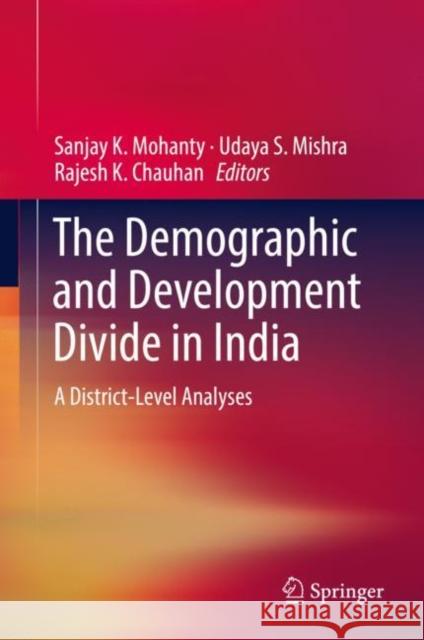The Demographic and Development Divide in India: A District-Level Analyses » książka



The Demographic and Development Divide in India: A District-Level Analyses
ISBN-13: 9789811358197 / Angielski / Twarda / 2019 / 558 str.
The Demographic and Development Divide in India: A District-Level Analyses
ISBN-13: 9789811358197 / Angielski / Twarda / 2019 / 558 str.
(netto: 461,12 VAT: 5%)
Najniższa cena z 30 dni: 462,63 zł
ok. 22 dni roboczych
Bez gwarancji dostawy przed świętami
Darmowa dostawa!
"The book would be of great use for economists, demographers, and scholars in other disciplines of social sciences, planners, policy practitioners and research students." (Sanatan Nayak, Migration and Development, August 4, 2020)
Sanjay K. Mohanty is a trained economist and demographer and Professor at the International Institute for Population Sciences (IIPS), Mumbai, India. Professor Mohanty has more than two decades of teaching and research experience and has guided several doctoral students in their maiden research work. He teaches courses on health economics and fertility measures at IIPS. His research interests include the economics of health and health care, economics of aging, multidimensional poverty and population dynamics. Prof. Mohanty has authored more than 80 research papers in international and national peer reviewed journals. Currently, he is associated with the “Longitudinal Aging Study in India (LASI), which is a joint survey by the T.H. Chan School of Public Health of Harvard University, IIPS and The University of Southern California. Prof. Mohanty was Visiting Scientist at the T.H. Chan School of Public Health during 2014-15 and C. R. Parekh Fellow at the Asia Research Centre, London School of Economics during January-April 2010. He was given the K.B. Pathak award in 2009 by the Indian Association for Study of Population (IASP) and the P.N. Mari Bhat Award by the Xavier Institute for Management (XIMB), Bhubaneswar for his research.
Udaya S. Mishra is a statistician/demographer and Professor at the Centre for Development Studies, Thiruvanthapuram, Kerala India. He is engaged in research and teaching on population and development issues and has a number of national and international publications to his credit. In recent times, he has served in various capacities in guiding scientific research in social sciences. During his two and a half decades of teaching and research experience, he has contributed research to the areas of ageing, health, nutrition as well as population policy and programme evaluation. His current research interest includes measurement issues in health, and equity focus in evaluation of outcomes. His scholastic distinctions include: (i) Takemi Fellow, in the Department of Population and International Health, T.H. Chan School of Public Health, Harvard University during 2003-05 (ii) Associate member of Southampton Statistical Sciences Research Institute, University of Southampton, UK and (iii) Expert group member to review the draft handbook on `Designing of Household Sample Surveys’ at the United Nations Statistics Division, New York.
Rajesh K. Chauhan is Joint Director with Population Research Centre (PRC), Department of Economics, University of Lucknow, India. He has a PhD in demography from The Australian National University, Canberra, Australia and master's degrees in statistics and population studies. He has served at the Directorate of Economics and Statistics of the Planning Department of the Government of Uttar Pradesh, India. His primary interest lies in the area of mortality and public health analysis, large-scale sample surveys, data management and analysis, money-metric welfare and poverty measures with special emphasis on measurement methodologies. He has extensive experience in working with the main Indian sample survey datasets e.g. National Family Health Survey (NFHS), District Level Household Survey (DLHS) and National Sample Survey (NSS). He has good understanding of CS-Pro environment for the data entry. He has several publications in reputed international and national journals and contributions in edited books.
This book is the first-ever volume which provides comprehensive information on demographic, health and development at the level of 640 districts in India. Central and state governments, developmental organizations, national and international NGOs and researchers require disaggregated data at the district level for many practical purposes. However, such information is not readily available for use. The editors, with a close-knit group of collaborators, have compiled data from reliable sources for each district of India and present the results in the form of composite indexes. The chapters rank districts within the state and vis-à-vis all districts of India to help readers understand intra-district and inter-district developmental disparities. They present spatial analyses that depict clustering of development. It is a ready reference for planners, researchers and students and provides scientific analyses that depict the clustering of development parameters at the district level.
This volume is meant for a wide readership interested in development in India, across population studies, sociology, economics, statistics, to regional development, and from academics, researchers, and planners to policy makers.
1997-2025 DolnySlask.com Agencja Internetowa
KrainaKsiazek.PL - Księgarnia Internetowa









